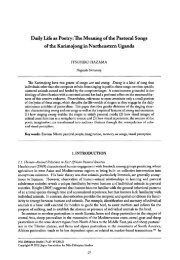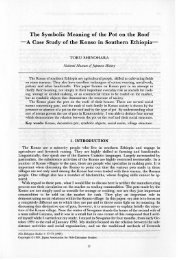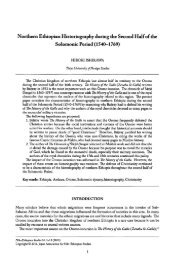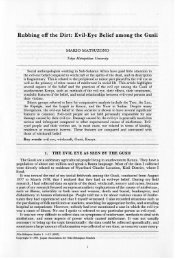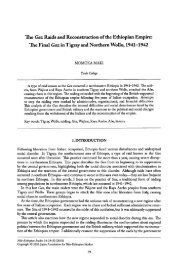Searching for a Way out of Social Discrimination: A Case Study of ...
Searching for a Way out of Social Discrimination: A Case Study of ...
Searching for a Way out of Social Discrimination: A Case Study of ...
Create successful ePaper yourself
Turn your PDF publications into a flip-book with our unique Google optimized e-Paper software.
58 Nilo-Ethwpian Studies<br />
ture, is unbearable and unjustifiable.<br />
In the Kafa zone, the government has taken measures <strong>for</strong> affirmative action in education, and<br />
Manjo can now enter the boarding school <strong>for</strong> minority groups established in Arba Minchi in 1998.<br />
This has produced a group <strong>of</strong> educated individuals. Today, Manjo graduates from this school are<br />
being appointed as teachers, police <strong>of</strong>ficers, and agricultural managers. Since the 2002 incident, campaigns<br />
<strong>for</strong> education launched by NGOs and the government have increased. Although only a few<br />
Manjo are educated, they have become a role model <strong>for</strong> the yow1ger generation attending school.<br />
The social life <strong>of</strong> the Manjo is also changing. When I spoke with Manjo, they <strong>of</strong>ten complained<br />
ab<strong>out</strong> the discrimination against them by the Kafa. They asked, 'Why aren't the Manjo equal to the<br />
Kafa?", "Why can't Manjo marry Kafa?", "Why is there no Manjo administrator?" The Manjo feel<br />
that they have been deprived <strong>of</strong> their right to self-determination and have begun to insist on this<br />
right. 'TI1e 2002 incident created a new opportunity to discuss the social discrimination <strong>of</strong> minorities<br />
and human rights issues.<br />
NOTES<br />
(1) Vaughan (2003: 276) reported the Manjo incident had occurred several days after the incident in Tepi.<br />
According to my in<strong>for</strong>mant, however, the Manjo incident and the incident in Tepi took place on the same<br />
day.<br />
(2) After I had completed my master's thesis on th.is incident, Vaughan published a paper in which she reported<br />
and analyzed the same incident (Vaughan 2006; see also Yoshida 2007). Although my analysis was<br />
obtained from my own field research, it mostly agreed with Vaughan's findings. In this paper, I present<br />
some details <strong>of</strong> the incident that Vaughan omitted and support these findings with statements from locals.<br />
(3) This article is based on in<strong>for</strong>mation and data collected in my research in the Kafa zone, which was conducted<br />
i.n three phases: (1) from January to March 2005 in Bita wiiriida; (2) from August 2005 to February<br />
2006 in Bita wiiriida, Gesha wii1·iida, Manjiwo wiiriida, and Decha wiiriida; and (3) from August to<br />
October 2006 in Gimbo wiiriida and Gesha wii1iida. Fieldwork in Woshero k'ebele and Shota k'ebele took<br />
5 months. Institute <strong>of</strong> Ethiopian Studies supported my research. The second and third phases <strong>of</strong> research<br />
were funded by Grants-in-Aid <strong>for</strong> Scientific Research (Japanese Ministry <strong>of</strong> Education, Culture, Sports,<br />
Science and Te chnology).1he research was conducted under the project "Historical Investigation <strong>of</strong> Ethnic<br />
Conflict in the Process <strong>of</strong> Nation State Building: A Comparative <strong>Study</strong> on Northeast African Societies"<br />
(Project Leader, Katsuyoshi Fukui, Kyoto University, Project No. 17251014).<br />
( 4) 1he immigration <strong>of</strong> the Amhara from northern Ethiopia to the Kafa zone occmred in three major phases.<br />
Initial groups followed Menelik's conquest <strong>of</strong> the area in 1897. The second influx took place dm-ing the<br />
Italian occupation; the third resulted from the resettlement policy <strong>of</strong> the Derg regime (Vaughan 2006:<br />
194).<br />
(5) Although its origin is unclear, it is generally understood that the word Gomoro derives from tl1e fact that<br />
the Kafa used to hunt and eat hippopotamus (gumare in Amharic) in the Gojeb River (Orent 1969: 47).<br />
(6) The Manno eat the meat remaining on the hide when they skin an animal. Because <strong>of</strong> this, they are discriminated<br />
against by t11e Kafa.<br />
(7) This estimate was given to me by the Head Administrator <strong>of</strong> the Kafa zone. According to this estimate,<br />
the Manjo account <strong>for</strong> 1.1% to 1.4% <strong>of</strong> the entire population <strong>of</strong> the Kafa zone. 1his seems to be more<br />
appropriate than an estimate mentioned by Freeman and Pankhurst (2003b: 76). Qyoting data from van<br />
Halteren (1996: 4), they estimated that the Manjo account <strong>for</strong> 5 to 10% <strong>of</strong> the entire population in the<br />
Kafa and Sheka zones.<br />
(8) Pottery is customarily made by women <strong>of</strong> the Man no and the Manjo.<br />
(9) According to Lange (1982: 267), the Manjo should be distinguished from slaves. The Manjo have their<br />
own clans, different from those <strong>of</strong> the Kafa. A Manjo in<strong>for</strong>mant told me that the Manjo and the Kafa were<br />
not the same, that the first king <strong>of</strong> the Kafa kingdom was a Manjo, and that the Kafa were newcomers and<br />
usurpers <strong>of</strong> the tluone. Lange (1982: 181) refere nced a similar story.<br />
(10) Mengistu (2003: 101) pointed <strong>out</strong> that the Manjo who live in the Sheka zone are not considered to be<br />
human.




